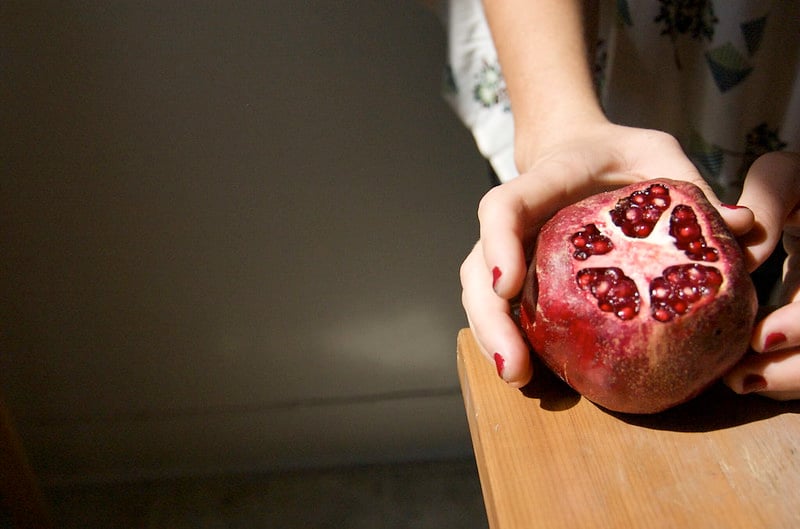
The pomegranate is deeply embedded in human history. For thousands of years, it has been a vital food and medicine for people in many different cultures. It represents life, rebirth, fertility, marriage, and wealth in every religion. The pomegranate tree is believed to be native to Greece. However, some people argue that it came from Persia, while others say that it came from Iran and Afghanistan and has been cultivated since ancient times.
The Pomegranate in Ancient Times
The pomegranate tree and its fruit have played a leading role in Greece since antiquity. It was called “roia” and its fruit “roa.” The Hellenistic period’s diminutive term “roidion” later gave the names “roido” and “roidi,” eventually leading to the modern name “pomegranate.” The fruit was used as a sacred symbol in Zoroastrianism rituals, representing the immortality of the soul and the perfection of nature. In his “Histories,” Herodotus informs us that during the Persian Wars, soldiers carried spears decorated with golden and silver pomegranates instead of spikes.
The ancient Chinese believed that the juice contained a “concentrated soul” that could offer immortality. The Babylonians believed that chewing the seeds before battle made them invincible. The Hittite god of agriculture blessed his followers with grapes, wheat, and pomegranates. Ancient Egyptians used to bury their dead with pomegranates, as their properties and symbolism as a fruit of fertility would help the deceased Egyptian to be reborn.
We find a reference to the pomegranate in Homer‘s Odyssey. The poet informs us that, along with pear, apple, fig, and olive trees, the pomegranate was among the trees cultivated in the garden of Alcinous, the king of the Phaeacians. In the myth of Tantalus, Homer also mentions pomegranate trees as one of the trees whose fruit hung above Tantalus. Every time he reached out to grab the fruit, the wind would blow it away, preventing him from reaching it.
In Ancient Greece
The Ancient Greeks believed that pomegranate seeds symbolized abundance, perhaps due to their quantity. They also represented fertility, eternity, and good fortune. Pomegranate trees were cultivated since antiquity and are mentioned in Homer’s Odyssey, where they grew on the island of Scheria or Phaeacia in the gardens of King Alcinous. Furthermore, Theophrastus and Hippocrates also mention the fruit for its therapeutic properties. It seems the pomegranate was red gold since ancient times.
The pomegranate was also closely linked to the Eleusinian Mysteries, as priests wore wreaths made of pomegranate branches during these ceremonies.
Many archaeological findings prove that the pomegranate fruit was known in the Mediterranean during antiquity, as it was reflected in ancient art.
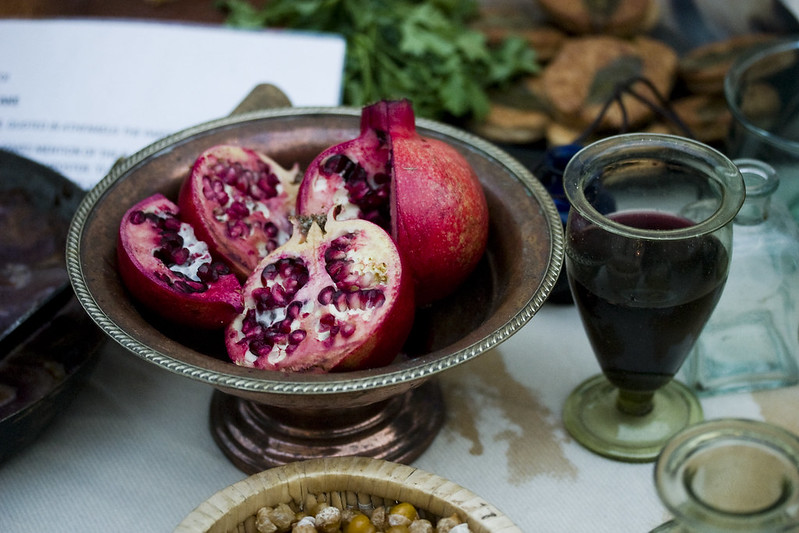
Pomegranates were painted on vessels in Milos. In Akrotiri of Santorini, excavations brought to light tephra containers with pomegranate fruit motifs. In Crete, Minoan treasures depict the fruit in 17th-century BC frescoes, and a beautiful necklace with gold pomegranate motifs has been found in ancient Mycenae. The National Archaeological Museum in Athens has in its storage a magnificent bronze pomegranate discovered on the Acropolis.
In Greek mythology, the pomegranate is believed to have originated from the blood of Adonis.
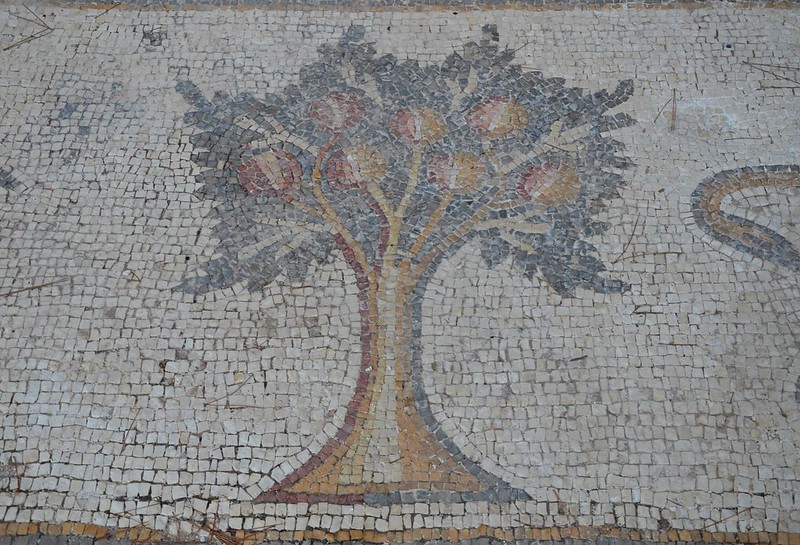
The pomegranate holds a prominent position in the myth of Persephone and her forced marriage to Hades, the god of the Underworld. Hades abducted Persephone and took her to the Underworld to become his wife. Dimitra, Persephone’s mother, and goddess of fertility mourned her lost daughter, causing all things on earth to cease growing. Zeus, Persephone’s father, ordered his brother Hades to release her.
Hades complied with the request but tricked her by offering her a pomegranate, and she ate six seeds. Persephone was freed by Hermes, but the Fates decreed that anyone who consumed food or drink in the Underworld was doomed to spend eternity there.
Since Persephone had tasted food in the Underworld, she was obliged to spend one-third of each year (the winter months) there and the rest of the year with the gods.
During these three months, while Persephone sits on the throne of the Underworld next to her husband Hades, her mother Demeter grieves and no longer grants fertility to the earth. This was an ancient Greek explanation for the seasons.
Influenced by the myth of Persephone, early Christians began to associate the pomegranate with the concept of resurrection. Furthermore, for them, the multitude of seeds contained in a single fruit indicated that it was a symbol of purity and unity under one power.
In Greece, the cultivation of the pomegranate tree is older than that of the almond and apricot trees and is contemporary with the cultivation of the olive tree, vine, and fig tree. Homer mentions the pomegranate, describing the gardens of King Alcinous of the Phaeacians:
“Outside the gate, in the courtyard, he has a large garden,
four acres in extent, with a fence all around,
and inside, many tall, lush trees are growing in abundance,
apple trees, golden-fruited pomegranates, pear trees with luxuriant foliage,
sweet-fruiting fig trees and sturdy, flourishing olives.”
(Homer’s Odyssey, VII 112-116)
The “enclosed garden,” depicted on many silver Corfu coins, is likely a symbolic representation of Alcinous’ gardens.
The pomegranate (roía) is also mentioned in the myth of Tantalus.
“And there I saw Tantalus, heavily tormented,
standing up to his chin in the waters of the lake,
thirsty, but unable to take a single drop;
Tall trees hung their fruit above him,
pomegranates, juicy pears, apple trees laden with apples,
sweet-fruit fig trees and olives on their branches,
and whenever the old man tried to stretch out his hands,
the wind raised them high into the shadowy clouds.”
(Homer’s Odyssey, XI 582-592)
In traditional medicine, pomegranate has been, is, and will be an exceptional remedy for all.
The ancient Indian medical system also known as Ayurveda, the Science of Life, uses not only the seeds but also the flowers, the fruit rind, and the root bark. Each part of the plant has its benefits and, therefore, specific therapeutic properties: Fresh fruit juice is considered a strong tonic, especially for the digestive and circulatory systems.
The bark is said to have anti-inflammatory properties and is therefore used to treat sore throats. The substance extracted from the roots is used as an antiparasitic. These are just a few examples: Ayurvedic medicine uses pomegranates to treat about a hundred different conditions.
Traditional Chinese medicine also believes in the beneficial properties of this fruit. In Tibetan medicine, ground pomegranate seeds mixed with cinnamon, cardamom, and pepper are a remedy for the digestive system.
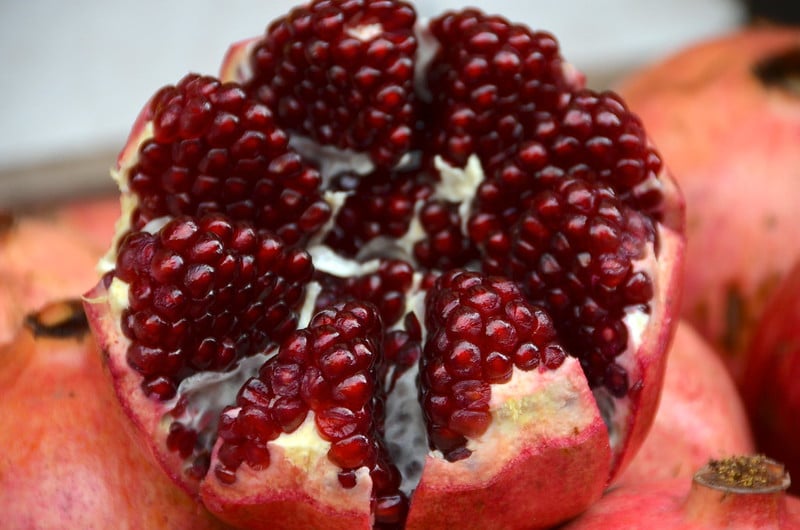
Nutrients and polyphenols
Pomegranates are rich in nutrients and vitamins, such as vitamin C, vitamin K, dietary fiber, phosphorus, potassium, and folic acid. Additionally, they contain polyphenols, which are powerful antioxidants that help protect the body from free radicals and reduce inflammation.
Some studies have suggested that consuming pomegranate juice may have potential health benefits, such as reducing the risk of heart disease, improving blood flow, and lowering blood pressure.
Pomegranate in modern times
The breaking of the pomegranate on New Year’s Day is a Greek custom that continues to this day, as the red nutritious fruit is considered a symbol of life and good fortune.
The ripe fruit’s distinctive appearance and long lifespan result in us admiring it in wonderful table compositions. Today, it is considered one of the most nutritious juices rich in antioxidants, which we can squeeze like an orange.
We drink it as is or use it in cooking. The most common use is in green salads, but it also goes well with meat dishes, chicken, and game. It makes excellent sweet and sour sauces with a distinctive aroma and taste. When shopping for it, we must choose the fruit relatively heavy, with a flawless peel and beautiful color.
It can be stored for several days outside the refrigerator, and for several months in the refrigerator’s fruit compartment, while the seeds can be preserved perfectly in a freezer bag in the freezer.
Today, Greek pomegranate farming is on the rise. One of the best examples lies on the outskirts of Olympus, in Elassona, where the love for pomegranates gave birth to a small, family business, called Ode to Pomegranate.
In this business, Stefanos Poutas cultivates and collects pomegranates from his pomegranate trees, and then creates sauces, juices, jams, and dressings.
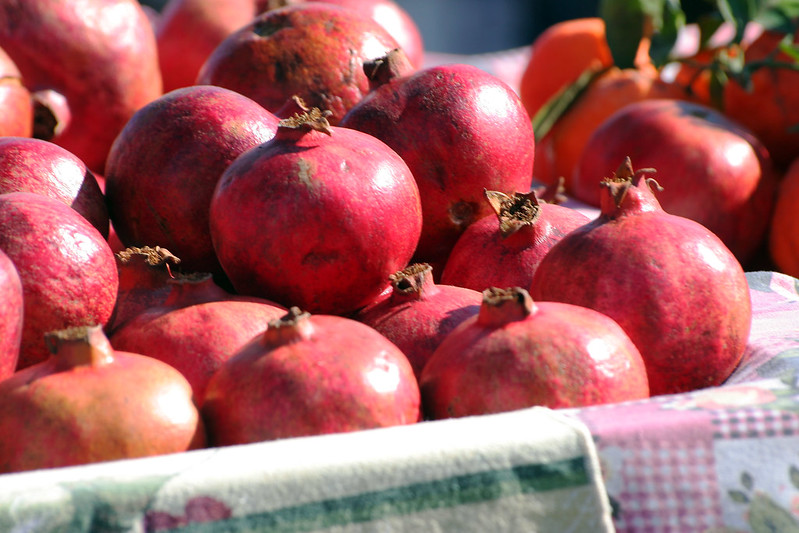
At his online store for pomegranate, you can find a plethora of exceptional products that add a unique flavor to whatever you make. The pomegranates, which are cultivated organically with care and passion, belong to the worldwide pomegranate varieties Wonderful and Acco, which can be consumed as table fruit and also used for juicing. Poutas’ estates are free from pesticides, herbicides, and chemical fertilizers.
In fact, only organic fertilizers are used, as required by the rules of Organic Agriculture. This way, fresh, tasty, and authentic food reaches the consumer, with respect for the environment and the natural life cycle of ecosystems. The cultivations are inspected and certified as Organic by Q-check Bio, and also officially Vegan-certified. All the products are free of sugar, gluten, and preservatives.
The business’ flagship is none other than pomegranate juice, and Stefanos ensures that every sip of their juice is enjoyable as well as pleasant, without astringency. To achieve this, they squeeze only the seeds of the pomegranate, after first removing the skins, resulting in what they claim to be the best tasting pomegranate juice on the market.
https://greekreporter.com/2023/04/07/pomegranate-ancient-greece/?fbclid=IwAR2teYf-gERZ3RGqQQ0oB6QLoLSa7eydprT-RKGOGrQlZYGqannsQdOf-kY
By
No comments:
Post a Comment